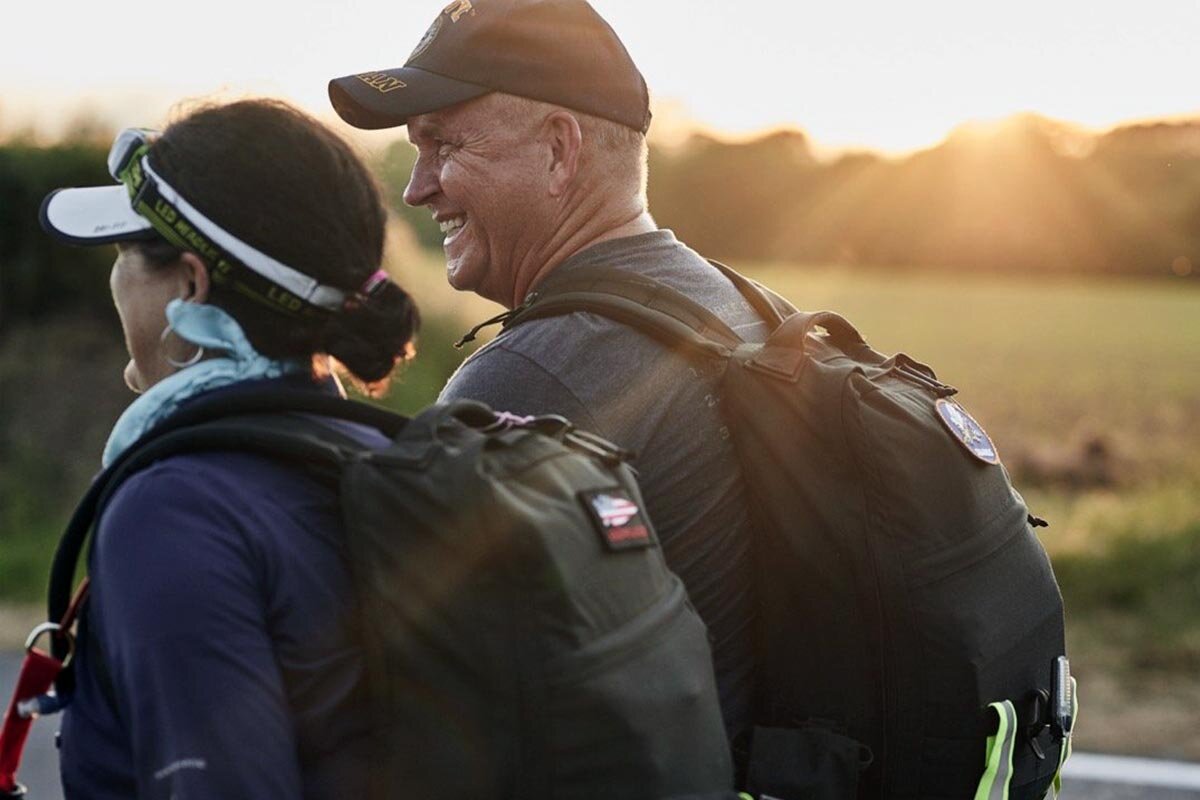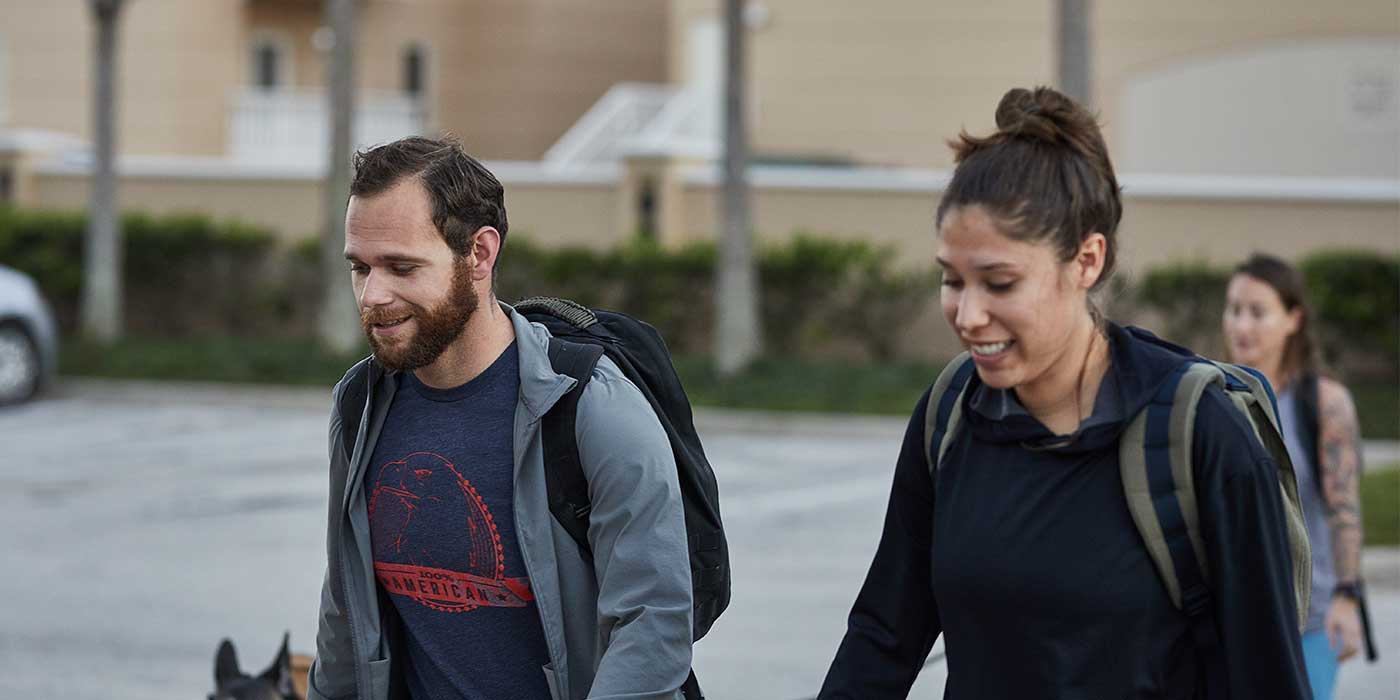Rucking vs. Running: Pros and Cons
Rucking and running each build character, improve fitness, and positively effect mental health, but they're functionally quite different. Which burns more calories? Which is easier on my knees and back? Can I do both?
Let's answer some common questions and check out some pros and cons of rucking vs. running.

1. Injuries & Longevity
Perhaps the most important questions in the rucking vs. running conversation surround injuries. As more and more runners take to the roads, injury prevention has become essential to any athlete wanting to reach his or her goals. Michael Easter (author of The Comfort Crisis) says the key to improving health and fitness over time is to “surf the edges of our tolerance and comfort zone so those edges expand.”
Find the edges, learn to navigate their discomfort and challenge, and watch them expand.
But not all exercises are created equal, and some put us on unsteady ground, too close to the edge.
Researchers at the University of Pittsburgh tracked 451 soldiers over a year of training. Of the 28 injuries that came from exercise, 18 injuries came from running, 7 injuries came from lifting weights, and only 3 came from rucking.
This data makes sense.
Pain and injury are more associated with high impact exercise like running. Our joints and muscles must absorb more impact while running—even at slower paces. It’s not called “runner’s knee” for nothing.
Increasing distance and intensity gradually while rucking or running is the key to staying healthy and seeing long-term benefits. Runners, however, deal with more impact and have a higher rate of injuries.
Research tells us that rucking causes less injuries than running ✅
Runners are more likely to end up injured ❌
2. Gear & Expenses
Rucking and running both require very little gear to get started. Runners only need a good pair running shoes, and with just some weight in a pack anyone can get started rucking.
Runners, however, can all agree: it’s best to get fit by a professional for quality running shoes.
The high impact and speed of jogging and running is hard on shoes. A run-specialty shop is your best bet to make sure your running shoes will be durable enough to withstand the pounding.
And while good shoes (or boots) will make any rucking workout better, you really can start with what you’ve got. Since it’s a lower impact exercise, rucking does not necessarily require expensive shoes to get started.
Grab any pack, toss some weight in, and head out the door ✅
New runners should head to a run-specialty shop for a proper shoe fitting ❌
3. Does Rucking Build Muscle?
Yes! Rucking builds muscle and improves strength in your whole body. Your core, glutes, hamstrings, quads, back, and shoulders will all benefit from walking with weight. Even your feet will become stronger and more durable.
This is one of the biggest benefits of rucking vs. running. Running is a powerful exercise to develop strong legs and feet, but those muscle groups runners often neglect fully engage while wearing a rucksack.
Ruckers might not need additional core and leg exercises to stay balanced across different muscle groups. Just throw on a rucksack and you'll feel a variety of muscles engaged, even when standing still. Plus, core exercises like planks are more "fun" when wearing a rucksack.
Running is primarily a cardiovascular exercise. Rucking is best for improving your cardio while getting strong.
Save Time, Pick Up a Rucksack
Because rucking is best for improving your cardio while getting strong, it really can save time. Imagine reaping the strength benefits of gym workout and the cardio benefits of a run at the same time. Sound great? That's basically how rucking works. It engages all the muscles of a good weightlifting session, while improving your cardio.
Strong muscles, heart, and lungs. We like the sound of that.
Also known as Active Resistance Training™ (ART), which is part active cardio and part strength training, rucking will burn significantly more calories than walking. With the added benefits of permanent metabolic gains from stronger muscles at a fraction of the cost to your knees, and plenty of benefit to your heart.
Ruckers get a full body workout ✅
Runners need accessory work to build muscle and strength ❌
4. Calories and Weight Loss: Maximum Benefits
Our Rucking Calorie Calculator is a great place to start planning your fitness goals. You’ll find that jogging and rucking burn a similar number of calories while rucking places much less stress on your joints, particularly your knees.
When you speed up to a decent running pace (past the point where you can carry a conversation), running will burn more calories than rucking. But while it burns more calories, it may not be as sustainable. Most people can't run as far as they can ruck (remember, rucking is lower impact), so a longer ruck will develop strength and might burn more calories than a short run, and the full body engagement will benefit your health over time.
If runners tend to get injured more often, more time with a rucksack and less time running might keep you healthy and active, which is a much better approach to burning calories, weight loss, and building a healthy lifestyle.
Rucking torches calories and is an effective tool for weight loss (read some testimonials) ✅
Running burns more calories than other exercises, but may not be as sustainable as rucking ❌
5. The Social Benefits
Rucking and running can both be individual or group exercises. Most cities have running clubs and rucking clubs where you can get a workout, meet new people, and enjoy community activities.
Social fitness clubs always embrace and amplify the best qualities of the sports they represent. Ruck clubs and run clubs are no different: try out different clubs and find a community that suits your personality and goals.
Most rucking and running clubs are suited for people with different experience and fitness levels. They’ll have pace groups or leaders who make sure no one is left behind, or alone. Just show up with a good attitude and a desire to learn something about someone else.

Joining an Official GORUCK Club is a great way to stay accountable in your fitness goals. Fitness and wellness are better when you’re surrounded by badass guys and gals who want the best for each other.
We think the best part about rucking is the people. You will too. ✅
Running clubs are easy to find and often have different pace groups to suit anyone’s experience and ability ✅
6. Versatility: When and Where Can You Run and Ruck?
Rucking can be done anywhere. Our favorite place is anywhere outdoors with friends, but treadmills, city streets, stairs, or parks & trails all work with your rucksack.
Running is pretty similar: anywhere your running shoes can go, you can run.
However, with a rucksack you can carry extra food and water, and gear for changing weather. What does that mean? You can often ruck farther distances than you can run. A 10 mile run might seem daunting in the summer (Where are water stops? How many energy bars can I fit in my running pack? Do I need sunscreen? A rain jacket?), but you can fit plenty of water, food, and supplies in a rucksack.
Rucking also has more versatility in fitness. Stair climbers build leg strength and cardiovascular endurance at the same time, but they don’t go fast enough to run on (and it probably isn't safe to do so).
Running might help if you’re ever late for a flight, but the benefits of rucking extend to anytime you’re carrying weight. Hauling school books, a work laptop, or camping gear is rucking. Rucking prepares you for daily life, and gives your daily carrying of goods a new purpose.
Rucking can be done anywhere and prepares you for the efforts of daily life ✅
Running is as versatile and useful as rucking ✅

7. Rucking vs. Running: Mental Health
The mental health benefits of rucking and running are clear. They both get you outdoors, help you make friends, and change your body for the better. Sunshine and fresh air, community, and fitness.
Social fitness helps with accountability and support and surrounds you with people who seek challenge, knowing well the benefits of a strong heart, lungs, and muscles.
That’s powerful.
Get a rucksack, add weight, go for a walk with friends. Rucking is a positive force for mental health ✅
Running outdoors improves mental health as good as every other outdoor fitness routine. Grab some sunglasses, lace your shoes, and head out to get your cardio fix ✅
Frequently Asked Questions
Does rucking make you a better runner?
Absolutely. Rucking is a great cross-training exercise for every runner’s toolbox. It engages the upper body and core directly, while contributing to strong legs. It’s a great low-impact recovery exercise that focuses on cardio and strength, what we call Active Resistance Training™ (ART). Rucking will complement any running program.
Is rucking better for your knees than running?
Rucking is a lower impact exercise than running. While rucking, you’ll always have one foot on the ground (unlike running). Because of this, the impact on each foot is lighter and less stressful for your joints.
Is rucking better than walking?
Rucking burns more calories than walking and builds strength and muscle over the same time and distance.
Can rucking replace running?
Rucking burns calories, builds strength and endurance, and improves cardiovascular performance. If your goal is to improve fitness, rucking can replace running. But if becoming a better runner is your goal, nothing will help you meet your goals better than running.
Is it okay to ruck every day?
Our beginner’s guide to rucking is a great place to start. Yes, you can ruck every day, but you shouldn’t start with that much volume. Take it slow, add weight and volume gradually, and take rest days as needed. You’ll notice muscle soreness in new areas, and you don’t want to overdo it.
How does rucking change your body?
Rucking improves cardio, strength, and endurance. It builds strong legs, back, shoulders, and core muscles. It’s a total body workout, and one that can complement any fitness program.
What pace should you ruck at?
Maintain between a 15 and 20 minutes per mile pace while rucking. If your pace is consistently higher than 20 minutes per mile, you may want to lighten your load (read our beginner’s rucking guide for more tips).
Rucking vs. Running: Final Thoughts
To sum it all up, you need to pick the exercise that will move you closer to your goals. If you’re looking to set a personal best on the track, or at a local race, you should focus on running and introduce rucking as a lower-impact, recovery-minded workout.
Rucking is an exercise that boasts a variety of benefits, some you won’t get from running. It strengthens your back and shoulders, improves posture, and has a positive impact on lifestyle activities such as travel, commuting to work and school, and hiking.
Pick up a rucksack. Your mind, body, and character will all reap the rewards.
And always remember: humans are better than hardware, outside is better than inside, and together is better than alone.

